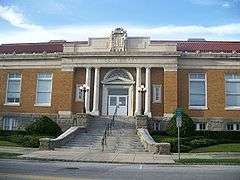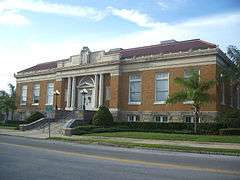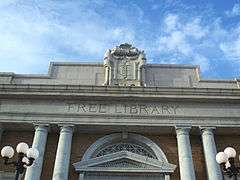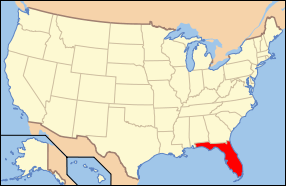Tampa Free Library
For other Carnegie Libraries, see Carnegie library (disambiguation)
|
Old Tampa Free Public Library | |
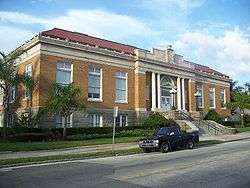 | |
  | |
| Location | 102 E. Seventh Ave., Tampa, Florida |
|---|---|
| Coordinates | 27°57′37″N 82°27′38″W / 27.96028°N 82.46056°WCoordinates: 27°57′37″N 82°27′38″W / 27.96028°N 82.46056°W |
| Area | less than one acre |
| Architect | Fred J. James; Aulick, Bates & Hundall |
| Architectural style | Classical Revival |
| NRHP reference # | 91000618[1] |
| Added to NRHP | May 16, 1991 |
The Old Tampa Free Public Library (also known as the Exceptional Children Education Center) is a historic library in the Tampa Heights neighborhood of Tampa, Florida. Located at 102 E. 7th Avenue, it was one of 10 Florida Carnegie libraries to receive grants awarded by the Carnegie Corporation of New York from 1901 to 1917.[2] It was designed by Tampa architect Fred J. James and constructed from 1915-1917. It was added to the U.S. National Register of Historic Places on May 16, 1991.
Steel magnate and philanthropist Andrew Carnegie provided funding for more than 3,000 Carnegie libraries in the United States, Canada, and Europe.[3] The library was built using a $50,000 grant from Carnegie. The library's first director was Helen V. Stelle.
It was Tampa's main library until 1968. It includes a T-plan, masonry, brown and yellow brick atop a rusticated granite basement, and is topped by a barrel tile roof. The building was rehabilitated in 1999 by the City of Tampa for public offices.[4] It has been occupied by the administrative staff of the Tampa-Hillsborough County Public Library System since November 2016.[5]
Reasons for Closure
Built in 1915, the Tampa Free Library originally stood as Tampa's main public library. However, over the decades, the library was no longer able to adequately meet the needs of the growing population. Concerns over the small size of the library, lack of expansion, and inability to assist the growing population eventually led to a new building being constructed in downtown Tampa. The original building was constructed and designed to serve 50,000 people which was adequate at the time of its construction. However, by the early 1960s, Tampa maintained a population of 274,407 people. In addition, other old, historical libraries in Tampa were also unable to meet the needs of the public due to poor parking, small size, and cramped collections.[6]. This led to questions of whether newer, larger libraries should begin replacing the older, historical models. The Tampa Free library endeavored to cater to the population by expanding hours. In April 1960 the Tampa Public Library's expanded its hours, from 9 a.m. to 9 p.m. Monday through Saturday, increasing the library's open hours from 66 to 72 hours per week. This was done with the hope that it would be more convenient for people working downtown to visit the library.[7] However, eventually the need for space and change led to the creation of a new main library, currently titled the John F Germany Public Library on 900 N Ashley Drive. Opening on April 21, 1968, the John F. Germany Public Library still acts as the main library in the Tampa-Hillsborough County Library system.
References and external links
Gallery
References
- ↑ National Park Service (2010-07-09). "National Register Information System". National Register of Historic Places. National Park Service.
- ↑ Jones, Theodore (1997). Carnegie Libraries Across America. New York: John Wiley & Sons. ISBN 0471144223.
- ↑ Bobinski, George (1969). Carnegie Libraries: Their History and Impact on American Public Library Development. American Library Association. ISBN 0-8389-0022-4.
- ↑ "Tampa Free Public Library". Retrieved 11 October 2013.
- ↑ "Tampa Mayor Bob Buckhorn eyeing changes at site of downtown library annex".
- ↑ https://cdm16054.contentdm.oclc.org/digital/collection/p15391coll2/id/5186/rec/1
- ↑ https://cdm16054.contentdm.oclc.org/digital/collection/p15391coll2/id/4947/rec/17
